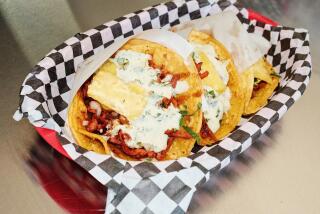How to become more sake savvy
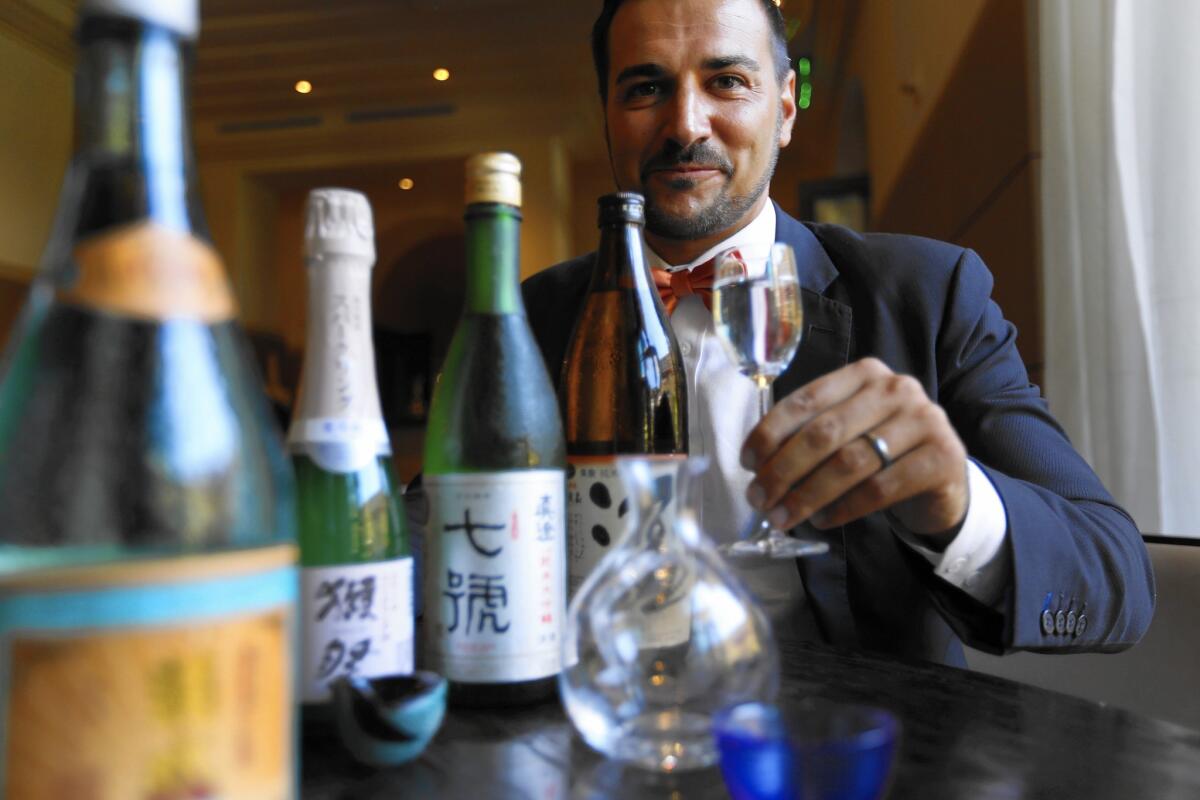
- Share via
If ordering sake at a sushi restaurant brings on a panic attack, you’re not alone. Sake is complicated, at least at first. To help decipher the labels and learn enough about the fermented rice beverage to order with confidence, we turned to sake educator Roberto Loppi.
Currently beverage director for the Montage in Beverly Hills, the Italian native is an experienced sommelier who has made it his mission to educate consumers and sommeliers about sake. He pairs sake with the tasting menu at Scarpetta in Beverly Hills, and he also created the sake menu for the Vietnamese restaurant District by Hannah An near West Hollywood.
How did an Italian sommelier get into sake? Loppi was working at Hakkasan in London and its other locations around the world, and was required to match sake with the high-end restaurant’s modern Chinese food. He began to educate himself by reading, tasting — and by going to Japan, where he met sake masters and visited breweries. He got hooked on the diversity and versatility of sake, which goes back about 2,000 years in Japan (the cultivation of rice dates back more than 7,000 years).
What fascinates Loppi about sake is the drink’s purity and freshness, which is a reflection of the Japanese culture. But he’s also fascinated by the contrast between tradition and technology. “When I visited some breweries, they might have the most advanced technique for checking the temperature of the fermenting mash and not even have a little stepladder to stand on but use an old beat-up stool. That kind of contradiction is fun,” says Loppi.
And while sake production is declining in Japan for a variety of reasons — including a downturn in consumption in the country — there are still about 1,200 sake breweries there. With the exception of 10 to 15 large-scale facilities, most are small, family-owned businesses with just a handful of employees. It’s a hard life, and fewer people are interested in becoming brew masters.
These days in Japan, the younger generation is drinking less sake and more spirits and imported wine. About 30% of Japan’s sake exports are destined for the U.S., which sounds impressive until you learn that only about 2% of Japan’s sake production is exported. Sake is made in America as well: In California there’s been a Takara Sake Brewery in Berkeley since 1982 and Ozeki brewery in Hollister since 1979. Loppi just visited the SakéOne facility in Forest Grove, Ore., just west of Portland, a city he says is very sophisticated.
Sake is not a rice wine but is fermented more like beer. Different strains of rice and yeast yield different flavors. The texture, or mouthfeel, is affected by water, which should ideally be soft, with low minerality. And while the style of sake is more important than where it’s made, sakes from the north of Japan, where it’s colder, tend to be a little bit drier and more delicate, while sakes from the south tend to be a bit bolder and richer in taste.
The most important factor in determining a sake’s style is the amount of milling given to the rice. Grains polished down to 60% or 70% will create a very different sake than grains polished down to 23%, say. This is because each rice grain has a starchy core surrounded by proteins and fat. The more starch and less proteins and fat you use, the higher the grade of sake obtained. Considering that sake is made with just four ingredients — rice, yeast, water and kogi (a friendly mold ) — it’s amazing how different the end products can be.
There are different styles of sake too. Sakes with “ginjo” on the label are fruity and aromatic, with an appealing acidity. Daiginjo, made from rice polished down to 50% or less, is even more premium, light and fragrant. Junmai ginjo is from Hiroshima in the south and is refreshing, sometimes slightly sweet with a compelling complexity and a lot of savory notes.
Sakes from the snowy Niigata, up in the north, are very dry and delicate, mostly because of the pristine water and air. Nigori is very different, milky, slightly effervescent with a gentle sweetness. It’s the result of letting some of the sake lees (dead or residual yeast left after fermentation) fall into the bottle, turning the liquid cloudy. (“Nigori” means cloud or milky.)
Next time you’re confronted with a sake menu, start by ordering a ginjo or daiginjo, and if you like that style of sake, try a more expensive one the next time. Just as in learning about wine, it’s important to taste great examples of each style. Each time you discover a sake that you like, you’re becoming more knowledgeable.
You can order with confidence at a sushi bar or Japanese restaurant. But don’t stop there. Try pairing sake with Chinese food or Mediterranean appetizers. The combinations that work can be surprising and wonderful.
::
Robert Loppi’s starter list for exploring sake
What sake to buy? Roberto Loppi picked five sakes in different styles, each of which would make a great introduction to the drink. Here are his picks with his tasting notes, though he cautions that there are many beautiful expressions of sake. It’s important to note that all of the breweries below make different labels with varying levels of quality and at different price points.
You can find some of these at District in West Hollywood, where Loppi created the sake list, and also at some Japanese restaurants, including the new West Hollywood outpost of the Las Vegas izakaya Aburiya Raku. Retailers with good sake selections who carry many of the bottles mentioned here include Hi-Time Wine Cellars in Costa Mesa, John & Pete’s Fine Wine & Spirits in West Hollywood and Wally’s Wine & Spirits in Los Angeles and Beverly Hills.
Kikusui Junmai Ginjo
From Niigata, a “blessed” region for sake making, this is an elegant sake in the look and in the flavor profile, delicate, dry, with refreshing tropical flavors. If your palate is set on Sancerre or dry Rieslings, you’ll like this one. Match it with scallops or burrata salad, or serve it as anaperitif. About $24 for a 720 milliliter bottle.
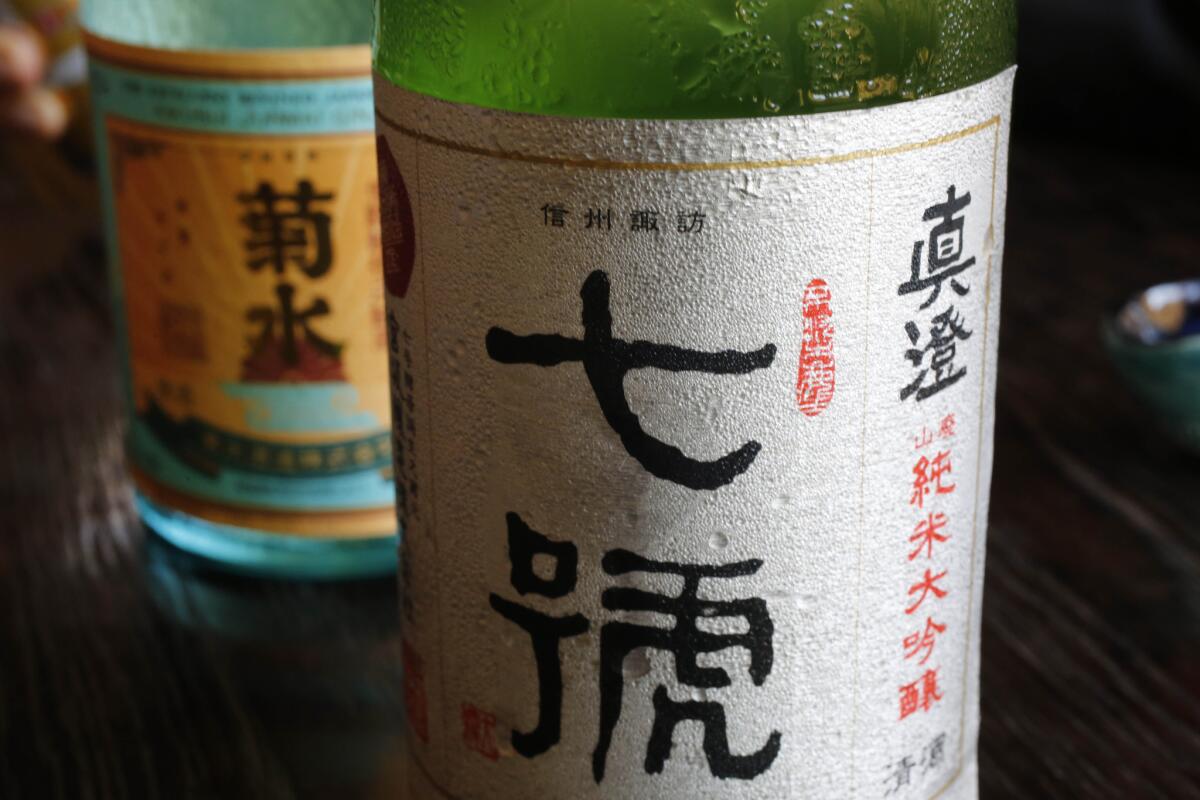
Masumi, shown here, is one of Japan’s premium sake makers.
Masumi Nanago Daiginjo
This doesn’t come cheap, but it’s a super-premium sake. One of my favorite producers, the Miyasaka brewery, has more than 300 years of tradition in the lovely village of Suwa, near Nagano. This label is named in honor of the famous yeast “N7,” which was discovered by this producer in 1946 and is now used by most breweries. A top-quality daiginjo is made by the lengthy process called yamahai, which leads to a little brighter acidity. Beautiful crisp citrus notes and texture to go with seared tuna or a seafood platter. About $66 for a 720 ml bottle.
Kamoizumi Shusen Junmai
Another of my all-time favorites, this one is from Hiroshima. It has a unique flavor profile — earthy, nutty and mushroomy — and is perfect served warm or with strong, savory dishes, both Asian and non-Asian, and with barbecued meat or hard cheese. About $35 for a 900 ml bottle.
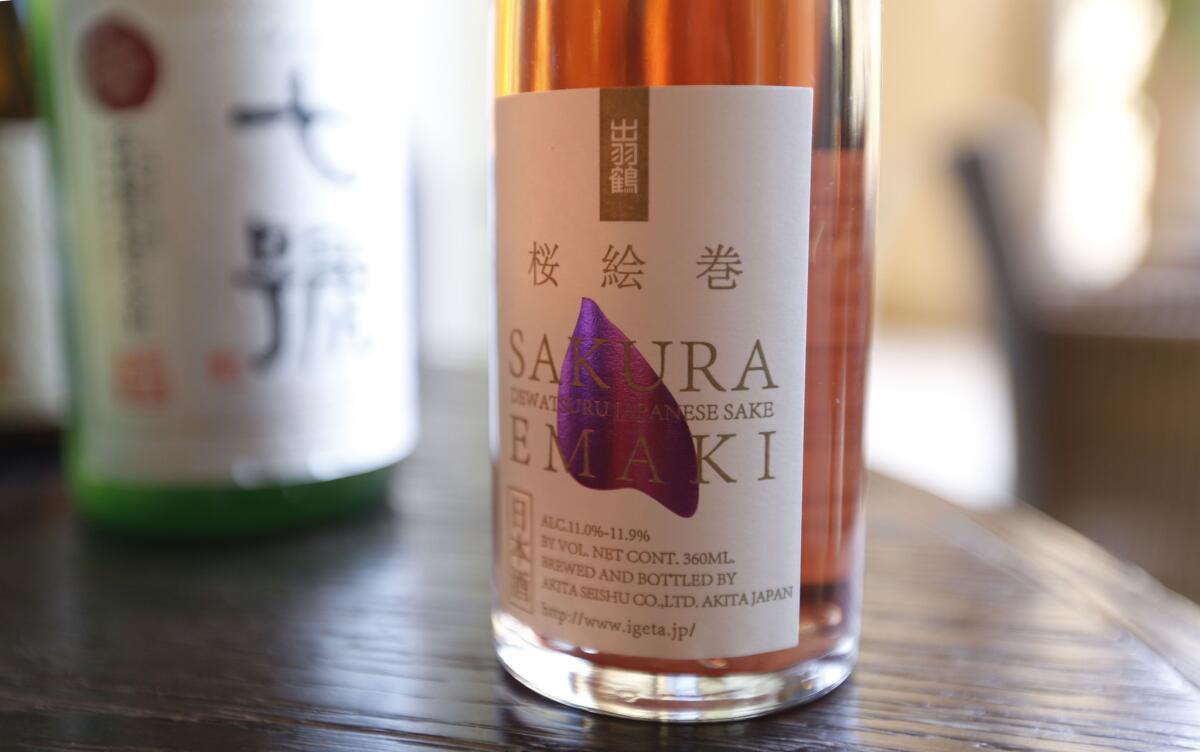
A “Rose” varietal made with red rice.
Dewatsuru Emaki Rosé
This is fun, made by another historic brewery, Akita Seishu, in the north. It’s unique and inexpensive, made with an ancient strain of purple rice that gives it an appealing pink color, and flavors of rose petal and cranberry. Sip it with grilled vegetables and tomato-based pizzas. Or mix it in a martini glass with vodka and lemon for a Japanese Cosmo. About $20 for a 360 ml bottle.
Dassai Daiginjo sparkling nigori
From the Yamaguchi region, this sparkling nigori with Champagne-like bubbles and an appealing creamy texture is widely available. Add a lime and serve it in a Champagne flute by the pool or match it with a fresh fruit bowl. About $30 for a 720 ml bottle.
::
How to buy, serve and savor sake:
• There are many styles of sake, including dry sakes, sweet sakes, aged sakes, fortified sakes, sparkling sakes and organic sakes.
• Since sake should be refrigerated, it’s best to buy it from a store that refrigerates its bottles (and keeps them away from strong light).
• Generally, drink sake within a year after it was produced. Since there is no vintage date, look for the bottling date on the label or the shipping date, when the sake left the brewery.
• Sake is usually gluten-free and sulfite-free and has no preservatives.
• You’re better off buying sake by style rather than region or producer. The style — ginjo, daiginjo, junmai — is the most important factor.
• When matching sake with food, the same basic rules can apply as for wine. Serve a lighter style, such as daiginjo, cold with seafood. Warm sake goes well with grilled meats. Nigori, which is always served cold, goes well with spicy food.
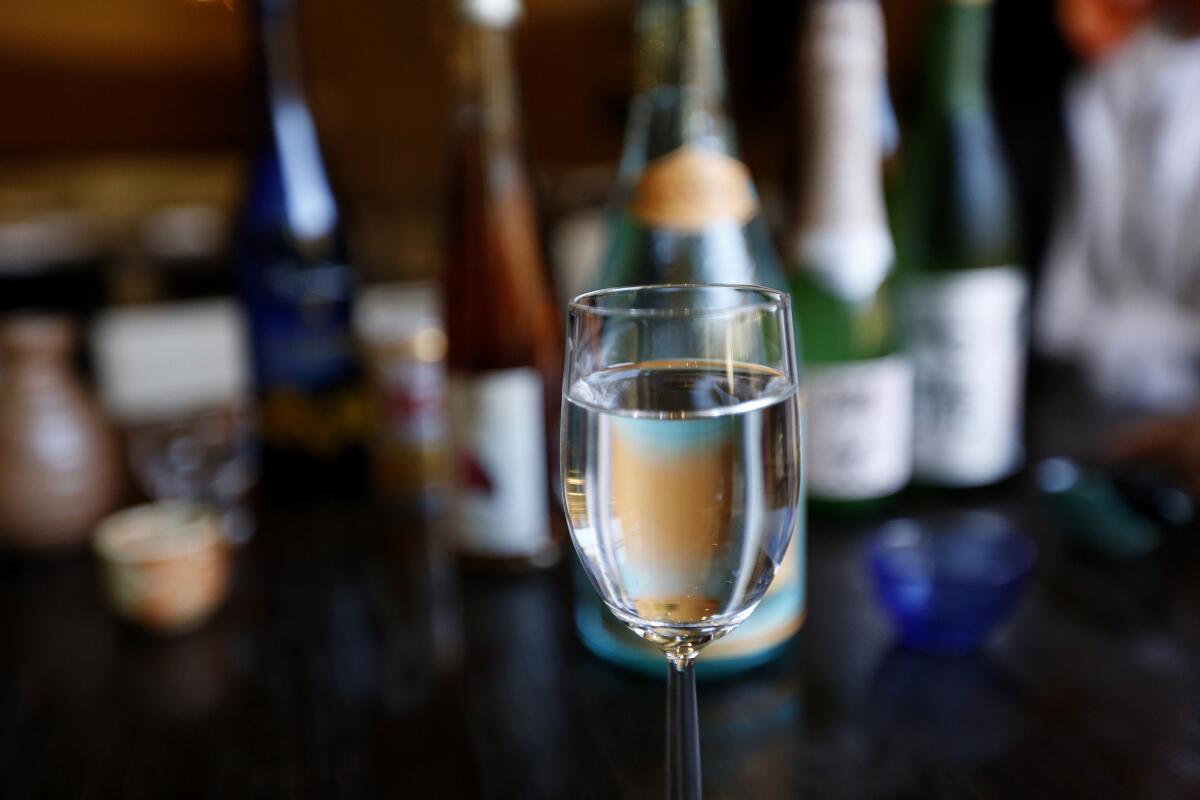
Grappa glasses are great for serving sake.
• Serve cold sake in white wine glasses. Serve warm sake in the traditional small ceramic cups called choko after warming the carafe of sake in a bain-marie (or a saucepan partially filled with simmering water).
• Don’t pour for yourself. Respect the traditions by pouring for your guests and let your guests pour for you as you savor the sake and engage in conversation.
• The same sake can be served at multiple temperatures — cold, room temperature or warm — for three entirely different taste experiences.
• For celebrations, try a sparkling sake.
More to Read
Eat your way across L.A.
Get our weekly Tasting Notes newsletter for reviews, news and more.
You may occasionally receive promotional content from the Los Angeles Times.


